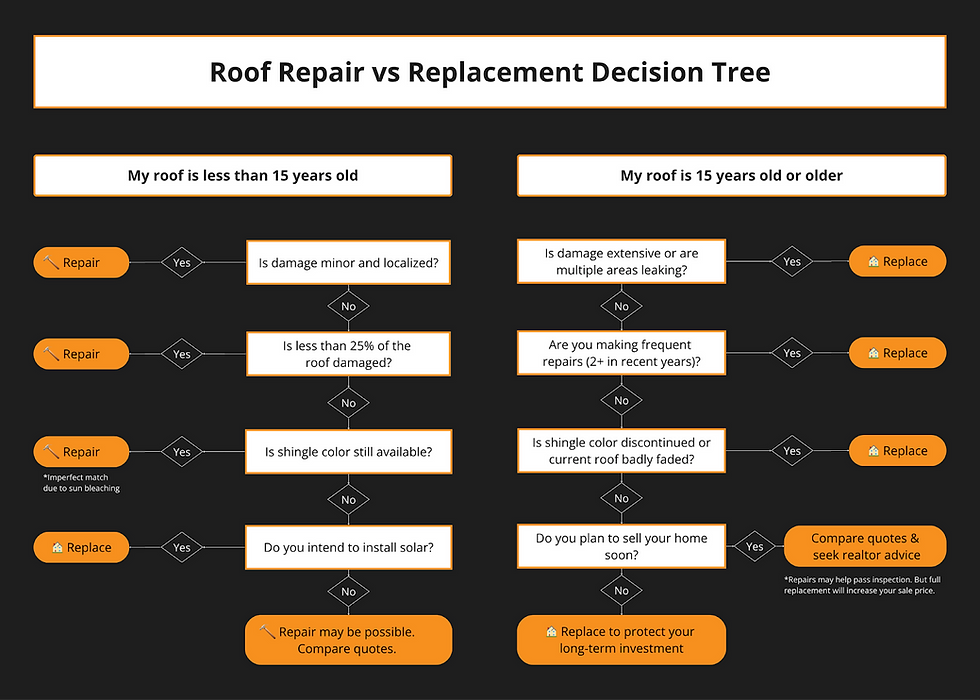What Happens During a Professional Roof Inspection Process and 3 Easy Checks You Can Do at Home
- Mike Mannion

- Oct 7
- 4 min read
Updated: Oct 29
Whether it’s been a rough Wisconsin winter or just a few years since your last check-up, your roof could be hiding issues that you won’t see until it’s too late. A professional roof inspection helps catch small problems before they become expensive repairs. And it’s not just for storm damage. Even in calm weather, an inspection can help you stay ahead of leaks, sagging, or shingle failures, all while protecting your insurance and warranty coverage.
We will walk you through the professional roof inspection process and give you a few safe, helpful ways to check your roof on your own.

Why Get a Roof Inspection Even Without a Storm?
Homeowners often wait for a hailstorm to think about their roof, but regular inspections are a smart part of home maintenance:
Catch early signs of damage before they escalate
Maintain insurance eligibility and preserve your roof warranty
Spot aging-related vulnerabilities before leaks develop
Prep your home for sale or resolve issues before appraisal
Address problems that could lead to discoloration and reduction of curb appeal
Identify concerns if you’re considering solar
What Happens During a Professional Roof Inspection Process?
Our certified and experienced team at Sun Vault Roofing performs a comprehensive, technical evaluation of your roof system:
Exterior Roof Inspection:
Look for missing, curling, or cracked shingles
Assess flashing around chimneys, skylights, solar tubes, and roof penetrations
Inspect vents, pipe boots, and seals
Examine fascia, soffits, and gutters
Evaluate for signs of hail or wind damage
Interior & Attic Inspection:
Look for water stains, moisture buildup, mold, or daylight through decking
Evaluate attic ventilation and insulation levels
Identify mold risks or improper venting
Structural Evaluation:
Check for signs of sagging, decking softness, or movement
Spot potential installation issues or manufacturer defects
Solar Readiness Check (if applicable):
Assess whether roof obstructions (e.g., pipes, vents, satellite dishes) are moveable
Determine ideal solar array locations based on roof shape and irradiance
Inspect and photograph electrical equipment, e.g., meter, panels, generator
Verify attic access and assess routing options
Evaluate load capacity for solar systems (if going with heavier conventional panels)

3 Easy Roof Checks You Can Do at Home
Many roof issues can be identified from the ground or inside your home, without the need to climb a ladder:
Look for visible signs from the ground:
Missing shingles
Algae or moss buildup
Debris like twigs, leaves, or branches after storms
Check your gutters and downspouts:
Excessive granules from asphalt shingles near downspout exits may signal material breakdown
Gutters or downspouts clogged by debris are a risk to your home. Clean them! Especially before winter.
Inspect your attic or ceilings indoors:
Stains, wet spots, or musty smells may signal roof leaks or condensation
These quick checks can help you catch potential issues early. For a deeper dive into what warning signs to look for, check out our blog on roof damage signs and how to spot trouble early.
(Left) - Example inspection finding: Cracked shingle with portion missing, likely letting water intrude. (Middle) - Example where the leaf accumulation is so great that a tree is growing on the roof. Don't let your roof become like this! (Right) - Example of algae/moss. This can hold water against the shingles and can hasten deterioration. Also reduces curb appeal as it’s usually visible from the ground.
Ladder Safety Basics (If You Decide to Climb)
We recommend that homeowners stay safely on the ground and leave the roof climbing to professionals. More than 500,000 people in the US annually are treated for ladder-related injuries according to the CDC, and 97% of ladder injuries treated in the emergency department happen at home. But if you do choose to use a ladder, follow all safety precautions, including:
Do not climb in wet, icy, or windy conditions
Inspect the ladder for structural damage before use
Place on level ground, avoid soft soil or slopes. Use levelers or a board if needed.
Avoid power lines or electrical wires
Keep three points of contact (two feet and one hand)
Don’t lean or overreach, reposition instead. Keep your belt buckle between the rails
Use the 4-to-1 rule (1 foot out for every 4 feet up)
Do not stand on or above the top 3 rungs
Use a spotter and ask someone to hold the base for added stability
Keep hands clear of rungs during extension and retraction
If you’re unsure or your roof is steep, call a professional. Your safety is most important.
When Should You Schedule a Professional Inspection?
Roof inspections are recommended if:
You’ve recently experienced hail, wind, or extreme weather
You notice any of the DIY warning signs above
Your roof is 10+ years old, even without visible issues
You’re preparing to sell your home
You’re considering solar roofing upgrades
Sun Vault Roofing provides thorough, documented roof inspections for homeowners across Wisconsin. If we find a problem, we walk you through the next steps; no pressure, no obligation.
📞 Call 608-608-1082 or book a free inspection today.








